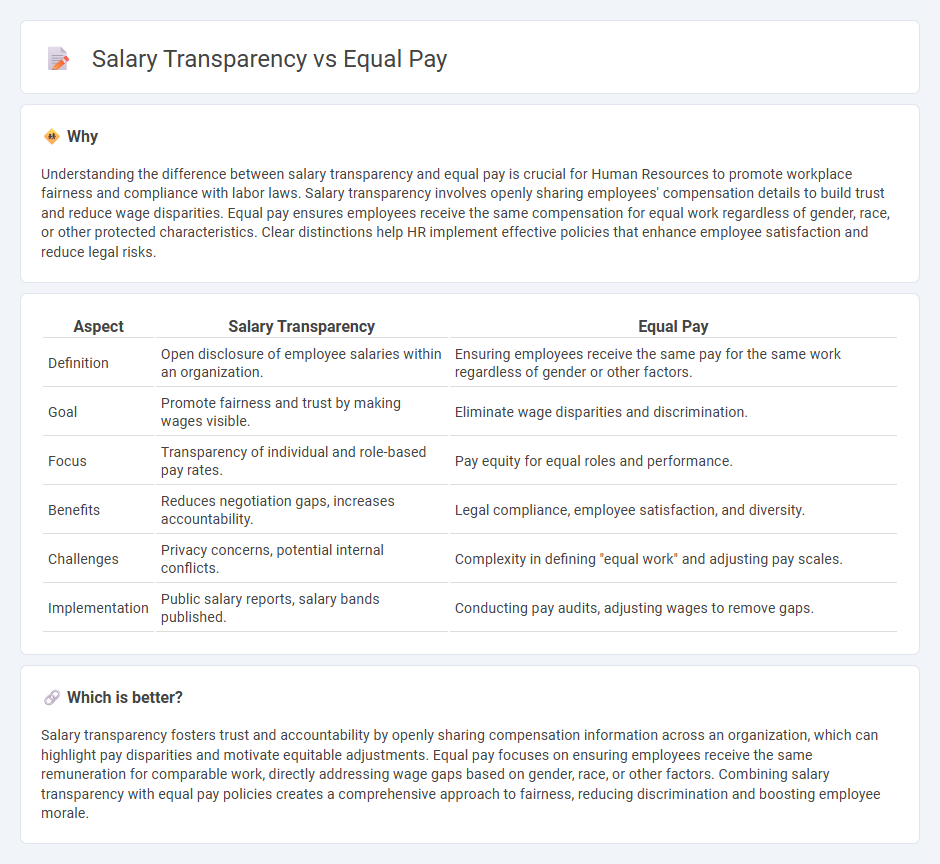
Salary transparency improves trust and accountability by openly sharing compensation information within organizations, while equal pay ensures fair and unbiased remuneration for employees performing similar roles. Addressing salary disparities helps reduce wage gaps related to gender, race, and other factors, fostering workplace equity and inclusion. Explore strategies to balance salary transparency with equal pay for a more just and motivated workforce.
Why it is important
Understanding the difference between salary transparency and equal pay is crucial for Human Resources to promote workplace fairness and compliance with labor laws. Salary transparency involves openly sharing employees' compensation details to build trust and reduce wage disparities. Equal pay ensures employees receive the same compensation for equal work regardless of gender, race, or other protected characteristics. Clear distinctions help HR implement effective policies that enhance employee satisfaction and reduce legal risks.
Comparison Table
| Aspect | Salary Transparency | Equal Pay |
|---|---|---|
| Definition | Open disclosure of employee salaries within an organization. | Ensuring employees receive the same pay for the same work regardless of gender or other factors. |
| Goal | Promote fairness and trust by making wages visible. | Eliminate wage disparities and discrimination. |
| Focus | Transparency of individual and role-based pay rates. | Pay equity for equal roles and performance. |
| Benefits | Reduces negotiation gaps, increases accountability. | Legal compliance, employee satisfaction, and diversity. |
| Challenges | Privacy concerns, potential internal conflicts. | Complexity in defining "equal work" and adjusting pay scales. |
| Implementation | Public salary reports, salary bands published. | Conducting pay audits, adjusting wages to remove gaps. |
Which is better?
Salary transparency fosters trust and accountability by openly sharing compensation information across an organization, which can highlight pay disparities and motivate equitable adjustments. Equal pay focuses on ensuring employees receive the same remuneration for comparable work, directly addressing wage gaps based on gender, race, or other factors. Combining salary transparency with equal pay policies creates a comprehensive approach to fairness, reducing discrimination and boosting employee morale.
Connection
Salary transparency directly supports the principle of equal pay by exposing wage disparities and promoting accountability within organizations. When companies openly share compensation data, employees can identify inequities and advocate for fair remuneration regardless of gender, race, or other factors. This transparency fosters trust and drives systemic changes that align with equal pay laws and diversity initiatives.
Key Terms
Pay Equity
Pay equity addresses the fairness of compensation for employees performing similar work, ensuring no discrimination based on gender, race, or other factors. Salary transparency promotes open disclosure of wages within an organization, helping to identify and rectify pay gaps that contribute to inequity. Explore how integrating pay equity strategies with salary transparency can foster a more inclusive and fair workplace culture.
Compensation Disclosure
Salary transparency enhances equal pay by openly sharing compensation data, which helps identify and address wage disparities across gender, race, and roles. Compensation disclosure fosters trust and accountability within organizations, driving fair pay practices and reducing discriminatory pay gaps. Explore effective strategies and benefits of compensation disclosure to promote pay equity in your workplace.
Wage Gap
Addressing the wage gap requires a combination of equal pay policies and salary transparency practices to ensure fair compensation across gender, race, and experience. Equal pay laws mandate that employees receive the same salary for equivalent work, while salary transparency encourages open disclosure of earnings to identify disparities and promote accountability. Explore more about how these strategies contribute to closing the wage gap and fostering workplace equity.
Source and External Links
Equal Pay Today - An organization dedicated to closing gender and racial wage gaps by promoting payroll transparency and equitable pay structures.
Equal Pay International Coalition - A multi-stakeholder partnership working to reduce the gender pay gap globally, led by the ILO, UN Women, and the OECD.
Equal Pay Day - An annual event symbolizing how far into the year women must work to earn what men earned the previous year, highlighting the gender pay gap.
 dowidth.com
dowidth.com